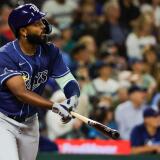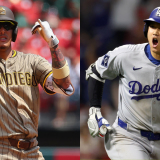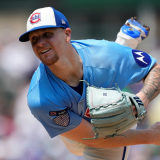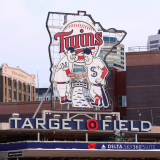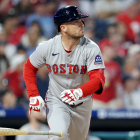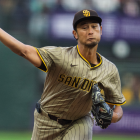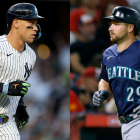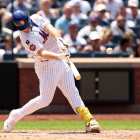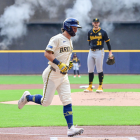
Cubs X-factor that could help them more than other contenders looking to buy at the MLB trade deadline
After falling out of first place in the NL Central, the Cubs are looking to plug some gaps in the roster
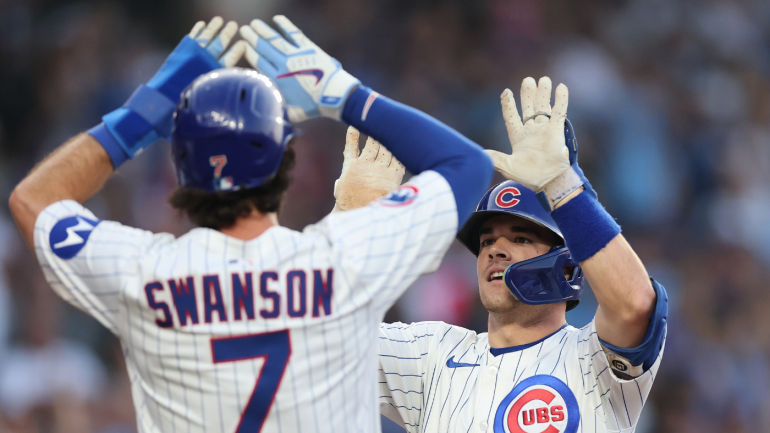
The Chicago Cubs entered Sunday in a peculiar position. Despite owning the best record in Major League Baseball, they also possessed the sport's slimmest division lead, sitting just a game ahead of the surging Milwaukee Brewers in the National League Central. The precariousness of the Cubs' position has since been made plain: they've slipped to second place after losing consecutive games.
Two days ago, the Cubs were in position for a first-round bye and home-field advantage throughout the playoffs. Today, they would have to settle for a wild-card spot. It's fair to write, then, that few teams have more riding on the nine days leading up to the July 31 trade deadline. The upside to winning the Central, and perhaps claiming the top seed in the NL, is simply too great for Chicago to ignore.
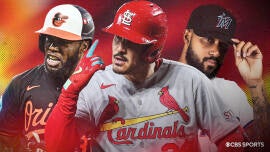
What that entails is to be determined, but the Cubs have some obvious needs: at third base, where they've received the worst OPS of any team, and in the middle of the rotation. Unfortunately for the Cubs, those needs are shared by several other contenders, including the New York Yankees and the New York Mets. On paper, it could be a fierce market for potential solutions, like Pittsburgh Pirates right-hander Mitch Keller and -- if the Arizona Diamondbacks sell -- third baseman Eugenio Suárez.
The Cubs, though, do have one plausible advantage working in their favor: an excess of young bats who are either big-league ready or close to it.
Front-office sources I've spoken with have indicated this isn't shaping up to be a great market for hitting additions. To put it simply: teams doing deep work are coming up with uninspiring trade targets, which means they'll have to get resourceful in their pursuit of help. That's where the Cubs' depth could come in handy, potentially allowing them to meet the needs of teams who might not fit cleanly into the classic buyer-or-seller dichotomy and who may be open to a strength-for-weakness swap.
The Cubs are particularly well positioned for such a deal because just one of their top nine at-bat recipients can qualify for free agency this winter: outfielder Kyle Tucker. Everyone else, beginning with one of the game's best double-play combinations (Dansby Swanson and Nico Hoerner) and extending to a full outfield depth chart, is under team control through at least the end of the 2026 season.
That doesn't mean the Cubs can exhaust their depth; it does mean they can justify moving some of it to improve their chances of winning the World Series.
With that in mind, let's break down a few of the Cubs' most obvious trade candidates.
- C Moisés Ballesteros: The book on Ballesteros remains the same: he's an impressive, contact-driven hitter with an uncertain defensive future. When the Cubs gave him a cameo in the majors earlier this season, he slotted into the lineup exclusively as the designated hitter. He's reliably produced at the plate, meaning he could provide value even if he shifts down the defensive spectrum.
- OF Owen Caissie: There are parallels between Caissie and Miami Marlins outfielder Kyle Stowers, who was traded last deadline in a deal for left-hander Trevor Rogers. (Stowers has since broken out and made the All-Star team; Rogers is sporting a 225 ERA+ in seven big-league starts this season.) Caissie, in his second go-around at Triple-A, has already matched his home run total (19) from last season in 51 fewer games. There's no denying his power, especially against right-handed pitching (he's recorded an exit velocity of 95 mph or greater on 56% of his batted balls with the platoon advantage), but there is considerable downside risk to his game stemming from a 30.2% strikeout rate.
- OF Kevin Alcántara: Alcántara, listed at 6-foot-6, has a dynamic skill set that includes above-average power and speed -- the latter of which has allowed him to remain a capable center fielder. Although he only just turned 23 years old, time is starting to work against him. This is his final option year, meaning that he'll need to be on the big-league roster next season or otherwise be exposed to waivers. That's a problem because Alcántara continues to post Caissie-like contact rates overall while whiffing on more than 40% of the non-fastballs he's seen at the Triple-A level.
- UTL James Triantos: Triantos is an undersized contact merchant who has been a polarizing prospect dating back to his amateur days. His long-term offensive viability remains an unresolved matter at this point, given that he's yet to produce at the Triple-A level. It doesn't help that there have also been concerns about where, precisely, he'll play most days defensively.
- OF Christian Franklin: Franklin actually leads the Cubs' Triple-A affiliate in average exit velocity and chase rate, nodding at his strength and discipline. He's on the older side already for a player without big-league experience (he'll turn 26 in November), and his ceiling these days is likely as a reserve.
- 1B/3B/OF Jonathon Long: Long is one of three members of the Iowa Cubs with a hard-hit rate over 50% (the others being Franklin and Caissie). Additionally, he both controls the zone and connects more often than a lot of the other names featured here. He's not a bigger name because, ultimately, he projects as a right-handed first baseman who is nearing his 24th birthday.
Note that the above group doesn't include third baseman Matt Shaw, who has split the season between the majors and minors, nor does it include anyone stationed below the Triple-A level. Granted, some of those players have significantly more trade value than others. But this is where market forces could prove favorable to Chicago.
At a time when everyone is seeking offense, the Cubs' ability to package together a few expendable, ready-made bats could prove to be the X-factor in negotiations -- and, as a result, the difference maker in the Cubs' World Series odds.
![[object Object] Logo](https://sportshub.cbsistatic.com/i/2020/04/22/e9ceb731-8b3f-4c60-98fe-090ab66a2997/screen-shot-2020-04-22-at-11-04-56-am.png)



